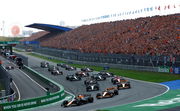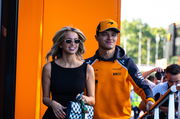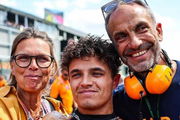
Imago
Formula 1 2022: Saudi Arabian GP JEDDAH STREET CIRCUIT, SAUDI ARABIA – MARCH 27: Charles Leclerc, Ferrari F1-75, and Max Verstappen, Red Bull Racing RB18, battle for the lead during the Saudi Arabian GP at Jeddah Street Circuit on Sunday March 27, 2022 in Jeddah, Saudi Arabia. (Photo by Zak Mauger / LAT Images) Images) PUBLICATIONxINxGERxSUIxAUTxHUNxONLY GP2202_172130_54I7099

Imago
Formula 1 2022: Saudi Arabian GP JEDDAH STREET CIRCUIT, SAUDI ARABIA – MARCH 27: Charles Leclerc, Ferrari F1-75, and Max Verstappen, Red Bull Racing RB18, battle for the lead during the Saudi Arabian GP at Jeddah Street Circuit on Sunday March 27, 2022 in Jeddah, Saudi Arabia. (Photo by Zak Mauger / LAT Images) Images) PUBLICATIONxINxGERxSUIxAUTxHUNxONLY GP2202_172130_54I7099
The Saudi Arabian Grand Prix has not disappointed in the previous two editions. From the 2021 incident involving Lewis Hamilton and Max Verstappen where the DRS zone ‘play’ of Verstappen didn’t go as well, to the last year’s back and forth involving the latter and Ferrari’s Charles Leclerc. While a lot of revisions have been made to the Jeddah Corniche Circuit in the warm-up to its third edition, the peculiar high-speed nature of the closely walled circuit never disappoints.
Watch What’s Trending Now!
Drag Reduction System or DRS is an artificial overtaking aid used to gain speed was introduced in 2011 and continues to stay in use. The overtaking is considered unfair trickery by some. That being said, the DRS battles and the cerebral prowess used to trump the opponent have given us some of the most entertaining bits of racing. The system helps the race car gain speed when the driver opens a flap in the rear wing of the car.
There are many rules and technicalities surrounding the said aid. The system cannot be used in the first two laps of the race. This is usually done because the cars are bunched up together at the beginning, as another rule states that it can only be used if the attacking car is within one second of the car it is pursuing. As soon as the car enters the said zone, the DRS device gets detected and is then used by the driver
ADVERTISEMENT
Why is DRS so powerful lately in F1 and especially in Saudi Arabia?
The DRS trick and the slipstream battle from last year turned many heads, leading to some even questioning the authenticity of such a system. While every track requires having at least one DRS zone, the peculiarity of Jeddah having three makes it an interesting race that allows the battles to go on and yet the attacking car has to be mindful about the place they want it in.
official sectors and DRS zones of Jeddah, very interesting choice for zone 2 pic.twitter.com/Z32vLZzjn5
— Tom¹ (@f1tomRB) November 25, 2021
ADVERTISEMENT
Jeddah is one of the high-speed track circuits on the calendar. The 6-plus kilometer circuit track with 27 recognized corners/turns sees drivers employ bizarre tactics to win the race. And while it may be an entertaining sight to watch, the outcomes may be dangerous with the drivers going at the highest speed possible and 80% of the track is covered in full speed. And the ironic bit about the track is that the drivers who ideally should be going fastest try to be the slower ones before the three DRS zones. The potential to use DRS is opened up if the driver is within one second of his rival before the DRS zone. The lockup of Charles and Max last year trying to be slower than each other is a testimony to the same.
Top Stories
“Have Some Shame”- Fans Tear Apart F1 Pundits’ Shocking 2025 Driver Ranking

Who Is Lando Norris’ Girlfriend? Everything You Need to Know About Margarida Corceiro

Why Does the Internet Dislike Charles Leclerc’s GF, Alexandra Saint Mleux?

Carlos Sainz Family: Everything We Know About His Parents and Siblings

Who Are Lando Norris’s Parents? Meet Adam Norris and Cisca Wauman

ADVERTISEMENT
2022 DRS Battle in Saudi – Will this year be the same?
The DRS zones in Saudi Arabia are interesting ones and this year they are set to see some changes to avoid gamesmanship. The final one of the three DRS zones was initially located in the braking zone before the final hairpin connecting two long straights. What the drivers did was they avoided overtaking to enjoy the DRS for a little longer. This led to erratic braking. To combat the dangerous situation arising out of it, FIA has now moved the third DRS zone from turn 27 to the main straight so that the 2021 situation involving Verstappen and Hamilton doesn’t repeat.
Last year, after the Ferraris dominated the curtain raiser, a battle was expected in the upcoming Saudi GP. While Red Bull’s Max Verstappen, won the race the DRS battle that followed was a delight for the onlookers. The pole man and the other RB driver, Sergio Perez, led the race till the 16th lap and an incorrect calculation of undercut by Ferrari and Nicholas Latifi’s crash turned the fate of the race.
ADVERTISEMENT
Now the Ferraris and Verstappen cashing on the bad luck of Perez began the show. The lead of the race kept switching back and forth between Leclerc and Verstappen. The DRS and the mindful swaps of the lead showcased the sheer intelligence that goes into play when racing at the highest level.

Reuters
Formula One F1 – Bahrain Grand Prix – Bahrain International Circuit, Sakhir, Bahrain – March 4, 2023 Red Bull’s Max Verstappen celebrates after qualifying in pole position with third placed Ferrari’s Charles Leclerc REUTERS/Nir Elias
The second of the three DRS zones runs down to the last corner, giving a peculiar opportunity to the driver in the attacking position to conquer the battle. But the catch lies in there being another DRS zone running all the way towards Turn 1, now even if one overtakes in that zone, the lead wouldn’t last long. An example of mental dexterity was witnessed last year when Leclerc tried to bait Max into going ahead of him, but the champion didn’t fall prey to it. And both the cars slammed brakes, not wanting to be the ones leading and eventually losing the position due to the disadvantage of the slipstream.
ADVERTISEMENT
The Ferrari and Red Bull were the two best-constructed cars in terms of speed. While it was last season’s news, the new development this season is the resurrected Fernando Alonso and his team that has improved by 2.4 seconds. Moreover, according to Lance Stroll‘s right-hand man, Nuno Pinto, Fernando Alonso‘s exploits at the Bahrain Circuit were only a prelude to a storm soon hitting the F1 circuits. In the FUm’s Vamos Falar podcast, Pinto said, “You have to analyze the reality of the numbers. In theory, Bahrain was not the strongest track for the team at the start of the championship. In theory, the car’s potential in Jeddah was better than in Bahrain, taking degradation out of the equation, talking about pure and hard competitiveness.” [Translated Via Google]
Watch This Story: F1 Drivers Threaten Saudi Arabian GP Boycott After Missile Attacks
What are your predictions for the upcoming Saudi Arabian GP? Let us know in the comments below.
ADVERTISEMENT
ADVERTISEMENT
ADVERTISEMENT
ADVERTISEMENT

